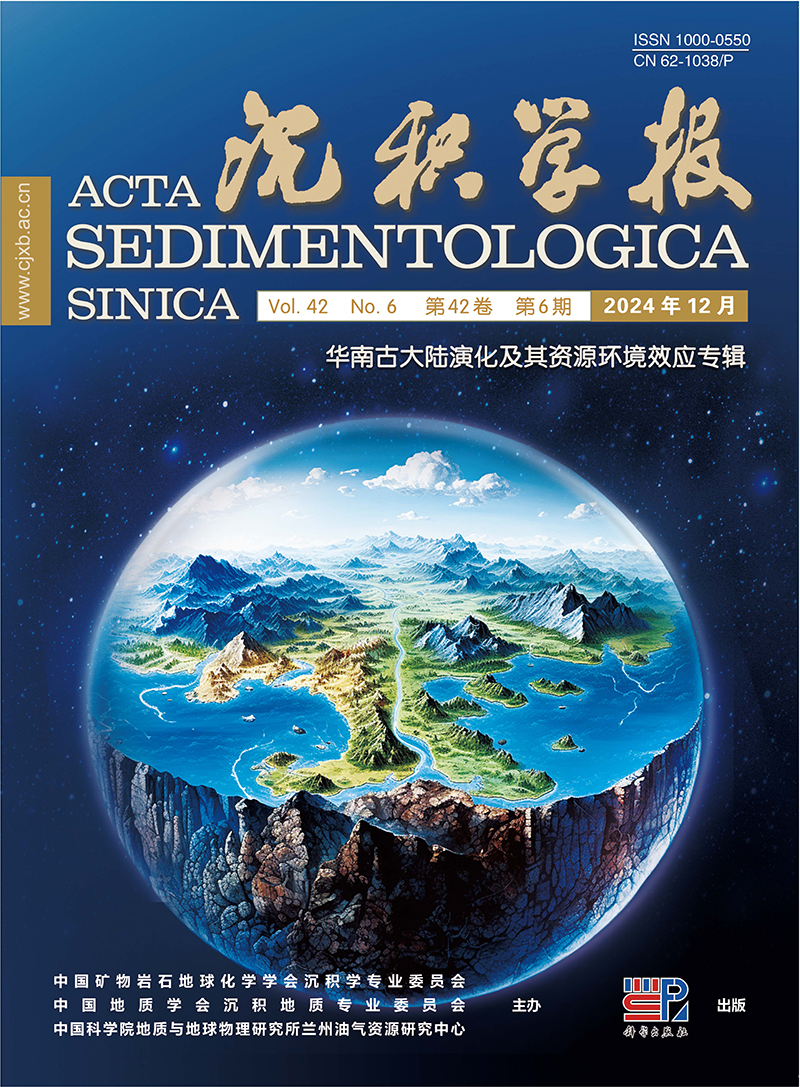HTML
-
大陆地壳与岩石圈地幔耦合成刚性的岩石圈板块,在塑性软流圈地幔之上发生周期性聚合与裂解,从而形成巨型克拉通或超大陆,即为超大陆旋回[1⁃2]。超大陆的周期性聚合和裂解不仅主导了全球尺度上的构造演变,同时对地质历史时期海平面升降、气候变化、生命演化以及资源能源效应等产生了决定性影响,长期以来一直是地球科学领域的研究前沿[2⁃4]。华南古大陆作为古—中元古代哥伦比亚(Colombia)超大陆和中—新元古代罗迪尼亚(Rodinia)超大陆的重要构成单元已被国内外学者普遍认可[5⁃10]。潘基亚(Pangaea)是地球历史时期最年轻的超大陆,而冈瓦纳(Gondwana)大陆则被认为是其最大组成单元。最新研究表明,东亚地区包括华南古大陆在内的众多陆块与东冈瓦纳(East Gondwana)均具有很强的构造亲缘性[8⁃9,11]。
华南古大陆北以秦岭—大别造山带与华北克拉通相邻,西北以龙门山断裂与松潘—甘孜地体为界,西南以哀牢山—红河断裂与印支地块相隔,其东南侧则为太平洋板块,是我国三大前寒武纪地质体之一[12](图1)。华南古大陆经历了元古宙到中—新生代多期次构造—岩浆—沉积—成矿事件[13],不仅是罕见的世界级多金属成矿省[14],也发育以四川盆地为典型代表的大型含油气盆地[15]。华南古大陆以其复杂的构造演化历史和深刻的地球动力学背景而著称,一直是国内外地质学界关注的焦点和研究的热点。

Figure 1. Tectonic map showing major landmasses and their boundaries in Asia (modified from reference [11])
近年来,有关从哥伦比亚到冈瓦纳演化过程中华南古大陆地球动力学机制、构造—古地理格局、形成演化规律及其资源环境效应等方面取得了一系列创新性成果和认识[6⁃9,13,16⁃18]。在此背景下,本文试图以超大陆旋回为主线,在力求全面收集整理、客观分析与评述前人已有成果资料的基础上,重点针对与古大陆汇聚—裂解相关的重大构造—岩浆事件、地层—沉积演化序列、成烃成矿作用以及极端气候事件等备受关注的科学问题,对华南元古宙—早古生代古大陆演化及其资源环境效应作概括性介绍,旨在抛砖引玉,引起同行的进一步重视,提升对华南地质演化及其资源环境效应的认识和研究水平。
-
与广泛分布太古宙地质记录的华北克拉通相比,华南大部分地区被中—新元古代和显生宙岩石地层所覆盖,仅有扬子地块周缘零星保留少量太古宙基底岩系[19](图2)。迄今,已报道的太古宙基底岩系主要有扬子地块北缘的崆岭杂岩、钟祥杂岩、陡岭杂岩、大别杂岩和肥东杂岩,西北缘的鱼洞子杂岩以及西南缘的撮科杂岩和越北Phan Si Pan杂岩(图2)。这些出露在不同区域的基底杂岩记录的地壳增生与再造时限、TTG岩石的源岩和熔融条件以及TTG岩浆作用向钾质岩浆作用转换的时限等均存在显著差异[19⁃24],暗示扬子地块在太古宙时期可能并非一个统一的块体,其地壳组分在横向上具有不均一的特征。

Figure 2. Distribution of the Archean⁃Paleoproterozoic basement outcrops in South China (modified from reference [20])
鱼洞子杂岩中的TTG片麻岩于~2.5 Ga时期经历了一次高级变质作用,以TTG为主的太古宙地壳物质经历了与碰撞有关的重熔作用,导致形成了大量2.48~2.45 Ga花岗质岩[24]。扬子西南缘在2.40~2.36 Ga期间也经历了一次碰撞事件,越北Phan Si Pan杂岩记录了峰期为700 ℃和0.65 GPa的一期变质作用,可能与弧—陆或陆—陆碰撞事件相关[25]。撮科杂岩中的2.36~2.3 Ga过铝质花岗岩属于后碰撞花岗岩浆作用的记录,指示它们最可能形成于后碰撞构造环境[26⁃27]。此外,扬子西南缘古元古代晚期沉积序列中的2.40~2.36 Ga碎屑锆石的εHf(t)介于-12.6~-1.5[28⁃30],也揭示了后碰撞垮塌前的地壳加厚。
越北Phan Si Pan杂岩中的早古元古代花岗岩形成于高温条件下加厚地壳的部分熔融[31],而川西会理地区~2.30 Ga辉绿岩具有E-MORB的地球化学特征,暗示当时应该已经演化为板内伸展环境[32]。撮科杂岩中~2.22 Ga变二长花岗岩和越北Phan Si Pan杂岩中~2.1 Ga片麻状花岗岩都属于A型花岗岩,可能形成于板片俯冲引起的弧后伸展环境,与俯冲增生事件有关[27,31]。
由上可知,扬子地块西缘于2.50~2.45 Ga和2.4~2.3 Ga期间经历了两次碰撞事件,与劳伦大陆西北部的Rae克拉通北缘和西缘的两期岩浆和变质事件(2.50~2.46 Ga和2.40~2.28 Ga)完全一致。因此,这两次碰撞事件被认为是劳伦大陆~2.5~2.3 Ga安第斯型Arrowsmith造山作用的构造响应,指示扬子地块与劳伦大陆西北部在哥伦比亚超大陆聚合之前已具有构造亲缘性[9,26⁃27,33]。
最近,在扬子地块东北缘陆续识别出新太古代末期至古元古代初期的岩石记录,如大别杂岩中的2.64~2.50 Ga贾庙花岗质岩石、2.49~2.41 Ga木子店TTG片麻岩、2.51~2.47 Ga浠水花岗片麻岩以及肥东杂岩中的2.50~2.44 Ga花岗质片麻岩等[20](图2)。结合鱼洞子杂岩和陡岭杂岩中的同时期岩浆和变质记录[24,34],可见该时期很可能是扬子地块北缘完成其初始克拉通化的关键阶段。然而,扬子地块北缘与西南缘古元古代早期岩石记录的构造内涵仍需进一步揭示,其分别与劳伦大陆西北部Arrowsmith造山作用存在何种联系也有待进一步明确,这将有助于准确认识扬子地块的早期形成与演化历史。
-
近年来,随着对地球历史上超大陆旋回认识的不断提高以及各类地质资料的持续更新,有关华南古大陆在哥伦比亚超大陆中的古地理位置已成为国内外地质学界的研究热点和争论焦点[7⁃9,33,35]。需要说明的是,扬子地块和华夏地块在古—中元古代时期各自应为独立的块体[9,16],因而在哥伦比亚超大陆重建过程中应分别予以考虑。
-
扬子地块古—中元古代地层主要分布于西南缘,包括东川群、大红山群和河口群[10,36]。这些地层遭受多次后期地质事件不同程度的叠加改造,表现为大红山群原生沉积构造经历了较强(高绿片岩相—低角闪岩相)变质作用和热液蚀变及变形活动的改造,而东川群和河口群尽管经历了绿片岩相变质作用,其原生沉积构造仍保留相对完整[37]。扬子地块西南缘发育多条近南北走向的断裂,以渡口—大红山断裂、安宁河—易门断裂、汤郎—撮科断裂和小江断裂等为代表,导致古—中元古代地层沿会理—东川—易门—元江一线呈南北向断续产出(图3)。近年来,随着扬子西南缘基础地质工作的不断深入,陆续发表了一系列高质量的同位素年龄数据,对该区域古—中元古代地层年代学格架的厘定提供了重要约束。

Figure 3. Distribution of the Proterozoic age outcrops in the southwestern Yangtze Block (modified from references [10,36])
东川群主要分布于云南省东川—武定—禄丰一带,自下而上依次划分为因民组、落雪组、鹅头厂组(黑山组)和绿汁江组(青龙山组),它们之间均为整合接触关系[10,36⁃38]。其中,因民组主要为一套砂泥岩组合,底部发育角砾岩;落雪组主要为中厚层白云岩,中部出露大量叠层石;鹅头厂组主要由炭质板岩组成,夹凝灰岩和硅质板岩;绿汁江组主要为一套碳酸盐岩组合,发育叠层石[10,36]。东川群下部可能存在更古老地层——汤丹群,推测二者为不整合接触[39],但有待进一步研究。东川群底部因民组凝灰岩的锆石U-Pb年龄为1 742±13 Ma[28],而侵入至因民组和落雪组的基性岩脉形成时代与之非常接近[28,40]。已发表的黑山组凝灰锆石U-Pb年龄均为1 500 Ma左右[30,38]。因此,东川群下部形成于古元古代晚期至中元古代早期,上部的沉积作用则开始于~1 500 Ma,但目前顶部时代仍缺乏准确有效的年龄限制。
大红山群紧邻哀牢山—红河剪切带,在云南新平县大红山、腰街、漠沙农场至元江撮科一带零星出露,自下而上由老厂河组、曼岗河组、红山组、肥味河组和坡头组构成[36]。其中,老厂河组主体为变质沉积岩,如石榴白云/石英片岩和大理岩,但在撮科一带主要为石英岩和变长石石英砂岩;曼岗河组与红山组岩石类型相似,主要为变火山角砾岩和凝灰岩等,区别在于曼岗河组中发育变质砾岩[41];肥味河组岩性以大理岩为主,而坡头组岩性则以炭质含量较高的变沉积岩为主。大红山群底部沉积环境为辫状河—三角洲,向上逐渐演变为大陆浅海或潟湖[41]。大红山群下部的沉积时代大致可限定在1 722~1 650 Ma[42],目前已发表的老厂河组、曼岗河组和红山组的岩浆岩锆石U-Pb年龄均位于该区间[10,36]。大红山群上部主要由碳酸盐岩和炭质泥岩组成,目前尚未获得可靠的年代学数据。
河口群大致呈北东—南西向沿四川省会理县黎溪—河口—姜驿一带分布,由大营山组、落凼组和长冲组构成[10,36]。各组内部岩性变化相似,基本由底部的变沉积岩过渡到顶部的变火山岩。沉积岩中常见沉积韵律结构,主要由含磁铁矿石英岩、板岩和千枚岩等组成[36]。大营山组钠质火山岩的锆石U-Pb年龄为1 722±25 Ma [43],而落凼组石英角斑岩的锆石U-Pb年龄为1 659±23 Ma [36]。结合已报道的河口群凝灰岩和基性侵入岩的锆石U-Pb年龄[44⁃46],可将该群下部沉积时代限定为1 722~1 659 Ma。最近报道的长冲组石榴云母片岩的锆石核部U-Pb年龄为1 468±28 Ma[47],有效约束了河口群上部的形成时代。
综上,东川群、大红山群和河口群的沉积初始时代应限定在~1 740 Ma(图4)。区域内同沉积岩浆作用主要发生在1 730~1 710 Ma和1 690~1 650 Ma,并于~1 500 Ma之后进入岩浆作用相对微弱的被动大陆边缘沉积阶段。分布于四川会理地区的通安组原被认为可以与大红山群、东川群和河口群相对比,但该岩组可能并非一套史密斯地层,而是由不同规模、不同性质、不同来源的构造岩块和强韧性剪切变形的基质组成的一套增生杂岩[47⁃49]。这些岩块主要由超基性岩、变辉长岩、变玄武岩、大理岩、硅质岩、变砂岩等组成,而基质主要为变粉砂岩、泥质板岩、碳质板岩、硅泥质岩、硅质板岩、云母片岩、千枚岩等。该套增生杂岩对重新划分华南古大陆前寒武纪大地构造格局具有重要意义,但其组成、结构及演化仍有待深入研究。

Figure 4. Schematic showing the Paleo⁃Mesoproterozoic stratigraphic correlation in the southwest margin of the Yangtze Block (modified from reference [10])
-
扬子地块的古—中元古代岩浆活动记录主要分布在北缘和西南缘。扬子北缘古元古代岩浆活动主要集中于2.1~1.9 Ga和小于等于1.85 Ga,分别对应于哥伦比亚超大陆聚合相关的碰撞造山阶段和后造山伸展阶段。后河杂岩以发育~2.08 Ga具岛弧地球化学特征的变花岗质岩为特征[50],而侵入至其中的~1.79 Ga花岗岩属于A2型花岗岩[51];崆岭杂岩中的~2.1 Ga玄武岩和安山岩显示岛弧地球化学特征[52],~2.0~1.95 Ga长英质岩浆岩形成于同碰撞构造体制[53⁃54],而~1.85 Ga基性岩脉和A2型花岗岩则形成于后碰撞伸展环境[55⁃56];钟祥杂岩中也报道有2.0~1.93 Ga过铝质花岗岩[57]、1.96~1.93 Ga I型花岗岩[58]以及1.85 Ga A型花岗岩[59]。扬子北缘普遍缺失中元古代早期地层及岩浆岩,直至中元古代中晚期神农架群和打鼓石群沉积启动后才开始发育岩浆—沉积活动[60]。
扬子西南缘古元古代晚期至中元古代早期的岩浆活动非常强烈,主要集中在1.75~1.70 Ga、1.69~1.65 Ga和1.52~1.50 Ga三个阶段,被认为与哥伦比亚超大陆的裂解有关[10,36]。第一阶段(1.75~1.70 Ga)主要发育双峰式岩浆岩,以指示陆内裂谷作用开始的~1.75 Ga海孜辉长岩和花岗斑岩为代表[61],随后于1.73~1.70 Ga进入岩浆活动高峰期[44];第二阶段(1.69~1.65 Ga)岩浆记录主要包括河口群钠质火山岩[45]、大红山群变基性火山岩[42]以及基性岩脉[28,40,46];第三阶段(1.53~1.50 Ga)岩浆活动主要表现为东川—会理—武定地区基性岩脉的侵位[40]和凝灰岩所记录的火山喷发作用[30,38]。此后,扬子西南缘进入构造—岩浆活动平静期,直至菜子园—通安增生杂岩带中的~1.37 Ga辉长岩的出现[48]。
-
尽管目前尚未在华夏地块发现太古代基底岩系的出露,但大量太古宙锆石颗粒的陆续报道[62⁃63],说明华夏地块下部可能广泛存在太古宙基底岩石。在武夷山北部陆续识别出大量结晶年龄为1.93~1.75 Ga的花岗质岩石,多数具有S型或A型花岗岩的地球化学特征,少量属于I型花岗岩[64⁃69],是华夏地块目前已知的最古老岩石(图2)。结合区域上该时期基性岩浆作用[70]和变质作用记录[64⁃65],华夏地块构造演化过程可大致分为1.93~1.88 Ga同碰撞阶段、1.87~1.85 Ga后碰撞伸展阶段和1.82~1.75 Ga陆内伸展阶段,可能响应于全球哥伦比亚超大陆的聚合与裂解。最近,有学者提出华夏地块该时期岩浆作用可能形成于大陆岛弧或弧后环境,仅与哥伦比亚超大陆的聚合有关[68⁃69]。
华夏地块出露的古—中元古代地层相对较少。具有代表性的古元古代地层为八都群,主要分布于武夷山北东缘的浙西南地区,自下而上划分汤源组、堑头组、张岩组、泗源组和大岩山组[71],主要由黑云斜长片麻岩、黑云片岩及斜长角闪岩等组成。这些岩石是由一套富炭高铝的陆源碎屑岩经角闪岩相—麻粒岩相变质作用形成的,后期经历过多期次构造—热事件的改造,显示明显的混合岩化作用[72]。碎屑锆石U-Pb年龄数据表明八都群最早沉积于~2 500 Ma,并经历了古元古代(~1.8 Ga)和早中生代(~250~230 Ma)两期麻粒岩相变质作用的改造[73]。中元古代地层在华夏地块上基本上没有出露[74],仅在海南岛的抱板杂岩中保留有相关记录,但目前关于海南岛是否属于华夏地块还存在争议[9,75]。
-
Rogers et al.[76]通过总结对比全球古—中元古代造山运动和裂谷事件,提出哥伦比亚超大陆的粗略重建模型(图5a),认为其形成于1.9~1.5 Ga期间,自~1.6 Ga开始裂解,并持续至~1.4 Ga。与此同时,Zhao et al.[77]通过对全球2.1~1.8 Ga碰撞造山带开展全方位对比,提出了更为详细的哥伦比亚超大陆重建模型(图5b),认为其于~1.8 Ga完成最终聚合,随后在几个关键地块边缘经历了长期的俯冲增生作用,于1.3~1.2 Ga最终裂解并过渡到罗迪尼亚超大陆的聚合和形成[78]。古地磁是进行超大陆重建的重要手段,可以半定量地描述地块的古地理位置。尽管基于古地磁数据与根据地质证据重建的哥伦比亚超大陆模型不尽相同,但二者的共识是其核心部分至少包括劳伦大陆、西伯利亚和波罗的这三个地块[79]。然而,由于缺乏高精度的古地磁数据,扬子地块和华夏地块在哥伦比亚超大陆重建中的古地理位置一直备受争议。
近年来,越来越多的地质证据表明,扬子地块古元古代经历了完整的从俯冲—碰撞到板内伸展的构造过程,与全球哥伦比亚超大陆的聚合与裂解同步[28⁃61]。然而,在最初的哥伦比亚超大陆重建模型中,并未考虑扬子地块[76],或将其与华夏地块作为整体置于外围[77⁃78]。Wang et al.[29]根据古—中元古代沉积岩的碎屑锆石年龄分布特征,提出扬子地块与澳大利亚具有亲缘性。随后,更为系统地研究发现扬子西南缘东川—河口—大红山盆地与澳大利亚北部的Leichhardt-Calvert-Isa盆地以及劳伦西北部Wernecke-Hornby Bay-Athabasca盆地拥有一个共同的沉积体系,进而提出三者具有构造亲缘性[37,80]。通过重大地质事件对比,越来越多的学者认为扬子地块与劳伦大陆西北部、西伯利亚南部和澳大利亚东北部在哥伦比亚超大陆构型中应彼此邻近[8⁃10,26⁃27,32⁃33]。然而,Zhou et al.[17]基于IOCG型铁铜矿床对比认为扬子地块应与澳大利亚东北部、印度西北部在哥伦比亚超大陆中相互连接,而Wang et al.[58]则根据造山带对比提出扬子北缘在哥伦比亚超大陆中可能紧邻澳大利亚西部和南非。
由于缺乏古—中元古代地质记录,关于华夏地块在哥伦比亚超大陆中重建的研究工作相对较少。通过岩石学、年代学和岩石地球化学对比,Yu et al.[73]提出华夏与印度西北部的低喜马拉雅地区在古元古代中期存在构造亲缘性。随后,Wang et al.[81⁃82]发现印度西北部古元古代北Delhi超群和Aravalli超群与华夏地块八都群的碎屑沉积岩具有年龄一致的沉积物源组成,指示该时期二者古地理位置邻近。1.97~1.92 Ga期间,印度西北部低喜马拉雅地区发育岛弧相关岩浆作用,随后发生了同碰撞和碰撞后岩浆事件[83],与该时期华夏地块(特别武夷山北部)构造演化过程相一致[69],也进一步印证了上述认识。尽管如此,也有学者提出了不同观点,如Xia et al.[68]认为华夏地块可能在哥伦比亚超大陆聚合时期位于北澳大利亚南缘。
由上可知,尽管扬子地块和华夏地块在哥伦比亚超大陆重建中的古地理位置存在诸多争议,但可以确定二者普遍经历了与哥伦比亚超大陆聚合和裂解相关的地质事件。值得注意的是,这些地质事件相关记录的分布存在明显时空差异性。例如,扬子地块北缘以广泛发育与哥伦比亚超大陆聚合有关的俯冲—碰撞记录为特征[50⁃59],而与哥伦比亚超大陆裂解有关的裂谷沉积—岩浆记录则主要分布于西南缘[10,36];同时,华夏地块古元古代地质记录绝大多数分布在其东部,而西部却极为少见[64⁃69]。这种时空差异性是代表当时扬子地块和华夏地块各自仍为离散的块体,还是与这些地质记录发育的古方位不同有关?值得进一步研究。
2.1. 扬子地块的地质记录
2.1.1. 古—中元古代地层
2.1.2. 古—中元古代岩浆活动
2.2. 华夏地块的地质记录
2.3. 哥伦比亚超大陆重建
-
自20世纪90年代以来,罗迪尼亚超大陆的重建一直是国际前寒武纪地质研究的一个重要课题,但其构型和组成陆块的相对位置一直存在争论[6⁃9]。特别是华南古大陆在罗迪尼亚超大陆重建中的古地理位置成为国内外相关学者长期关注的问题,争议的焦点在于它是位于核部[6⁃7,84⁃85]还是边缘[8⁃9,86⁃88]。究其根源,在于不同学者对华南古大陆形成与演化的认识存在明显分歧。
-
传统观点认为,华南古大陆是由扬子地块与华夏地块于中元古代末至新元古代初沿着江南(亦称四堡、晋宁)造山带碰撞拼贴形成[7,84⁃85]。江南造山带东起浙北,经浙西、皖南、赣东北、赣西北、湘西、黔东北、黔西南至桂北,长逾1 500 km、宽约200 km[87]。近二十余年来,围绕记录了华南古大陆形成过程的江南造山带,很多学者对其沉积地层、岩浆岩以及蛇绿岩套等开展了卓有成效的沉积学、岩石学、年代学和地球化学等研究,取得了一系列新的数据和认识[18,87⁃91]。
目前,对江南造山带的形成机制及演化过程存在多种认识。有学者认为江南造山带是由扬子地块与华夏地块于中元古代末至新元古代初的碰撞和拼贴所形成,进而提出它可能是全球格林威尔造山系统一部分的观点[6⁃7,84⁃85];有学者认为扬子地块与华夏地块的最终拼合发生于约830 Ma,导致了江南造山带内较古老地层(如四堡群、冷家溪群等)的变形变质和大量花岗岩的形成[18,87⁃90];还有学者认为江南造山带约830~820 Ma岩浆岩是弧—陆碰撞和造山带垮塌构造体制下新生地壳重熔的产物,而800 Ma之后的岩浆记录则是大陆裂谷相关岩浆作用的产物[92⁃93]。此外,Zhao[18]提出扬子地块与华夏地块之间的大洋岩石圈于1 000~825 Ma期间发生连续双向俯冲,随后二者发生软碰撞。通过系统解析江南造山带内各种地质记录的数据资料,Yao et al.[91]认为扬子地块与华夏地块的碰撞时限存在穿时性,并提出这一过程记录了罗迪尼亚超大陆边缘的增生造山作用。
最近,有学者提出江南造山带可能由扬子地块与大怀玉地体在新元古代碰撞形成,而华南则是由扬子地块与西华夏地块在早古生代拼贴形成[94⁃95]。然而,目前学术界的基本共识是多个离散的块体在新元古代早—中期拼合形成了统一的华南古大陆[16]。近些年,在扬子地块内部识别出多套近东西向展布的中元古代蛇绿岩,包括菜子园[47⁃49]、石棉[96]和庙湾[97]等。这些蛇绿岩暗示中元古代时期沿着石棉—庙湾[98]或者菜子园—庙湾[49,99]曾经存在一个或多个洋盆,并可能于~0.9 Ga发生碰撞拼合形成统一的扬子地块[100]。此外,华夏内部大陆地体和弧—盆体系拼合形成统一地体的过程也被认为可能发生于~0.92 Ga[101]。因此,扬子地块和华夏地块新元古代早期各自拼合形成统一的块体,很可能响应于全球罗迪尼亚超大陆的聚合,而华南古大陆可能形成于830~820 Ma[18,87⁃91]或早古生代[94⁃95]。综合前述哥伦比亚超大陆旋回背景下扬子地块和华夏地块的构造演化历史,可以看出具有复杂基底组成的华南古大陆的形成过程远比想象中复杂,仍有很多问题需要进一步研究来确定。
-
有关华南新元古代沉积盆地的研究可追溯至20世纪90年代初[102],但直至21世纪初才首次提出南华裂谷盆地开启时代与罗迪尼亚超大陆解体之间存在成因联系[103]。近年来,针对华南新元古代沉积盆地演化陆续开展了沉积学、地层学、年代学、物源分析和岩相古地理等方面的工作[74,104⁃107]。目前,关于华南~820 Ma开始形成的南华裂谷盆地已得到了越来越多的证据支持[5,103,108⁃109],但关于其形成的地球动力学机制一直存在着地幔柱相关陆内裂谷盆地[5⁃7]、俯冲相关弧后伸展盆地[86,88]和造山后垮塌相关裂谷盆地[92⁃93]等不同认识。
近年来,王剑等[105]对华南新元古代中期(820~635 Ma)沉积演化、沉积相、沉积旋回、事件沉积、多重地层划分对比等开展了详细研究,揭示了沉积盆地不同阶段的充填样式,并首次编制了华南前寒武纪5个重要时期的构造—岩相古地理图(图6)。应当指出的是,越来越多的资料证实,前~820 Ma不整合关键界面不仅代表了罗迪尼亚超大陆解体之后华南新元古代裂谷盆地的开启、新一轮沉积超覆的开始,而且应当作为华南新一轮构造旋回的起点与南华纪地层划分的底界[105,110⁃112]。华南新元古代裂谷盆地可分为东南缘(南华)、西缘(康滇)和北缘(西乡—花山)三大裂谷系,这些裂谷盆地的沉积充填演化序列非常类似,大致可分为裂谷幼年期(820~800 Ma)、裂谷成熟期(800~720 Ma)、早冰期(720~660 Ma)、间冰期(660~650 Ma)和晚冰期(650~635 Ma)等5个序列,各序列均具有明显的旋回性,其间的界面显示为伸展不整合面,充填样式以半地堑样式为主,裂谷系统具有主边界断裂、裂谷基、裂谷肩、调节带、构造滑脱不整合面等要素[104⁃105]。

Figure 6. Lithofacies and paleogeographic maps during the five depositional periods of the Middle Neoproterozoic (820⁃635 Ma) in South China (modified from reference [105])
华南新元古代裂谷盆地幼年期为快速沉降期,洪—冲积扇沉积与盆地水体直接接触,扇三角洲平原沉积狭窄或缺失,向上迅速变为饥饿盆地沉积,属于陡坡型扇三角洲。裂谷盆地成熟期的沉积物从幼年期盆地溢出,向早期的裂谷肩上超,扇三角洲平面面积加大,其前缘部分常为滨岸、障壁砂坝及潟湖体系,属于缓坡型扇三角洲和短程河流三角洲(图6a,b)。此外,王剑等[105]还借鉴现代大陆冰川模式,将华南新元古代冰期和间冰期的沉积相分为冰盖、陆相冰缘、海相冰缘和冰海(冰外)4个相带(图6c~e)。华南新元古代裂谷盆地5个重要时期的构造—岩相古地理记录了由陆变海、由滨浅海变(半)深海以及盆地由小变大的演化过程,反映了罗迪尼亚超大陆裂解的盆地响应[105]。
-
中元古代晚期至新元古代初期,罗迪尼亚超大陆的主体以哥伦比超大陆裂解时内部洋闭合(Introversion)的方式形成[113]。具体而言,即格林威尔造山带中包括1.24~1.22 Ga Elzevirian和1.20~1.14 Ga Shawinigan在内的增生造山作用将外来陆块拼贴到劳伦东缘[114],而随后大陆碰撞导致的广泛构造变形和高级变质则标志着主要造山事件的结束[6]。最近,有学者提出一个包含了亚马逊、南极洲、印度及西非等克拉通的巨大陆Umkondia可能先于罗迪尼亚超大陆形成[115]。新元古代中—晚期,罗迪尼亚超大陆外缘板块的俯冲作用与其内部岩石圈伸展—裂解显示出很好的时间耦合性,指示环超大陆的巨型俯冲带后撤可能是诱发其裂解的关键因素之一[116],而(超级)地幔柱活动对罗迪尼亚超大陆的裂解也具有一定程度的贡献[113,117]。然而,关于华南在罗迪尼亚超大陆重建中的具体位置,有着核心(澳大利亚东缘与劳伦西缘之间)、边缘(印度北缘与澳大利亚西缘之间)和外围(游离于超大陆主体之外)等截然不同的观点(图7)。
Li et al.[6,84]提出华南在罗迪尼亚超大陆中是劳伦大陆和澳大利亚中间缺失的部分(missing-link)(图7a),该模式认为扬子地块与华夏地块在新元古代早期(1.0~0.9 Ga)发生拼合,江南/四堡造山带是全球格林威尔造山带的组成部分。随后,罗迪尼亚自0.85 Ga开始裂解,华南从劳伦大陆和澳大利亚—东南极之间裂离出去,并伴随发育双峰式岩浆作用和裂谷盆地沉积[5⁃7]。然而,有学者提议华南位于超大陆的边缘位置,接近印度和澳大利亚或孤立在外围大洋中[86,88,91](图7b),该模式认为扬子地块与华夏地块新元古代中期通过多期岛弧俯冲增生完成拼合[18,91,101],随后扬子西缘持续俯冲导致南华裂谷系的形成[86,88]。最近,陆续发表了一系列华南新元古代沉积盆地充填序列(如马底驿组[118]、澄江组[119])的可靠古地磁数据,指示华南在820~750 Ma期间应位于高纬度地区,而非赤道附近的超大陆核心位置。
需要注意的是,多数学者关注的是华南在罗迪尼亚超大陆裂解时期的古地理位置,而鲜有研究涉及其聚合时期。Evans[120]最近提出了一个罗迪尼亚超大陆聚合时期的重建模型。在这个模型中,三个古大陆被认为自~1.1 Ga开始彼此汇聚,包括从哥伦比亚超大陆裂离出来的古老陆块(劳伦大陆、西伯利亚和波罗的)、来自哥伦比亚超大陆北部的原澳大利亚以及先于罗迪尼亚形成的巨大陆Umkondia[115]。约1.05 Ga,这三个古大陆沿着格林威尔造山带碰撞拼合形成以赤道为中心的“原罗迪尼亚(proto-Rodinia)超大陆”[120]。然而,同时期扬子地块发育以昆阳群为代表的被动大陆边缘沉积[99],指示当时可能未参与格林威尔造山作用。扬子西南缘发育1.03~1.01 Ga岛弧相关岩浆作用[100]和1.04~1.00 Ga弧后沉积作用[121],表明可能自~1.04 Ga开始发生大洋岩石圈俯冲。值得注意的是,扬子西南缘中元古代晚期构造演化过程可与印度西北部的Aravalli造山带相对比,指示扬子地块当时很可能与巨大陆Umkondia的核心地块具有古地理亲缘性[100]。
华南古大陆的形成和演化与罗迪尼亚超大陆聚合和裂解息息相关,其对大规模成矿、成藏事件具有重要的控制作用[14⁃15,110,122⁃123]。在罗迪尼亚超大陆聚散背景下,目前仍有很多有关华南古大陆形成和演化的关键科学问题亟待解决。例如,(1)中元古代扬子地块内部是否存在洋盆?如果存在,其残迹是石棉—庙湾蛇绿岩带或菜子园—庙湾蛇绿岩带还是其他缝合带?(2)扬子西南缘昆阳群、会理群及其相当地层的精确对比关系为何?其是否形成于共同的构造—沉积体系?(3)东华夏和西华夏是否于新元古代早期拼合成统一的华夏地块?随后与扬子地块沿江南造山带拼合形成华南古大陆?这些关键问题的解答对于准确理解华南古大陆形成演化及其与罗迪尼亚超大陆聚散的耦合关系至关重要。
3.1. 华南古大陆形成
3.2. 沉积盆地演化
3.3. 罗迪尼亚超大陆重建
-
自1929年丁文江首次提出广西运动的概念以来,近百年华南地质研究使得学界逐渐认同华南古大陆于早古生代时期经历了一次强烈的造山作用。该造山作用在华南东南部形成了一个巨型褶皱带,不同学者将其称之为华南加里东褶皱带[124]、华南早古生代造山带[125]或武夷—云开造山带[126],其西北和东南边界分别为安化—罗城断裂与政和—大浦断裂[127]。褶皱带范围内出露大量奥陶纪—志留纪岩浆侵入体和志留纪火山岩[126,128⁃129]以及北东走向为主的构造轴迹[125⁃126]。位于褶皱带东南部的武夷山—白云山—云开大山沿线地区出露奥陶纪角闪岩相—绿片岩相变质岩及经过强烈变形的紧闭褶皱[126],指示该区域应为造山带核部。褶皱带西北侧(安化—罗城断裂至张家界—贵阳一带)保留了一个以未变形变质和以志留纪碎屑岩沉积为主的残余前陆盆地[130]。因此,华南东南部地区可见一个清晰的早古生代盆山系统,由南东向北西依次保存造山带核部、造山带逆冲褶皱带和残余前陆盆地三个构造单元(图8)。

Figure 8. Schematic showing the tectonic pattern of the Early Paleozoic basin-mountain system in South China (modified from reference [130])
关于华南早古生代造山带的性质及动力学机制仍存在争议,主要存在如下三种模式。
(1) 陆内造山模式:一般认为新元古代早期扬子地块和华夏地块碰撞拼贴形成了统一的华南古大陆[13,16],随后响应于全球罗迪尼亚超大陆的裂解,转换为伸展环境形成南华裂谷盆地,但由于裂谷作用夭折而未形成新的大洋[105,126]。受华南及邻近亚洲块体与冈瓦纳大陆发生聚合作用的远程效应影响,华南东南部自中晚奥陶世发生强烈的板内造山作用[126,131⁃132]。这表现在该地区缺乏早古生代蛇绿岩和岛弧火山岩,早古生代花岗岩以强过铝质壳源岩浆为主,几乎没有新生幔源物质参与[133],而435~425 Ma中基性岩则由造山垮塌引发的减压熔融作用形成[128]。
(2) 碰撞造山模式:学者认为扬子地块与华夏地块之间发生早古生代俯冲碰撞导致洋盆闭合[134⁃135]。最近一些研究认为华夏地块可沿闽西北断裂带划分为东、西两个部分[136]。其中,西华夏在早古生代早期与东冈瓦纳北缘的澳大利亚碰撞而发生变形[95,137],奥陶纪—志留纪时期经历高温高压变质和部分熔融过程,同时发育大量S型花岗岩[133,137]。晚古生代,西华夏从东冈瓦纳北缘裂离,而东华夏于印支期沿着闽西北断裂带走滑到西华夏东侧[94⁃95]。
(3) 增生造山模式:学者认为扬子地块与华夏地块之间在早古生代有大洋分隔,理由是二者以江山—绍兴—郴州断裂带为界的前泥盆纪沉积序列、沉积环境和生物组合均存在明显差异[138⁃139]。早古生代晚期,古华南洋俯冲消减,形成一系列弧岩浆岩[134]、蛇绿岩[140]、洋岛—海山组合[141]以及俯冲—碰撞相关的花岗岩等[142]。因此,华南早古生代造山作用很可能响应于原特提斯洋演化[143]。
-
整体而言,华南古大陆早古生代岩石组合从南东向北西呈现规律性变化(图9)。位于造山带核部的寒武纪—奥陶纪地层以滨浅海相碎屑岩为主,志留纪地层则大部分缺失,仅在钦州—防城港一带及海南岛出露志留纪深水砂泥岩组合[130,144]。位于造山褶皱带的寒武纪地层以下部黑色页岩和上部碳酸盐岩为特征,奥陶纪—志留纪地层则过渡为浅海相灰色泥页岩和砂岩组合[130,144]。进入残余前陆盆地范围后,寒武纪—奥陶纪地层主要是台地相碳酸盐岩,晚奥陶世—志留纪地层则过渡为滨—浅海相砂泥岩组合[130]。

Figure 9. Lithofacies and paleogeographic map during the deposition of the Early Paleozoic in South China (modified from reference [130])
早古生代时期,华南古大陆上存在一个楔状形态、以碎屑岩为主要填充物的前陆盆地[130,145]。盆地充填物自南东向北西逐渐减薄[130],沉积中心逐渐向北西迁移[145],盆地内浅水古流向(交错层理、波痕、槽模等)也显示碎屑沉积物由南东向北西方向搬运[127,130]。盆地沉降和充填历史分析显示盆地沉降呈三段式发展:第一阶段为晚震旦世—寒武纪,沉降速率较慢,沉降区局限于华夏区;第二阶段为奥陶纪,沉降速率快,沉降区包括华夏和扬子东南部等广大地区;第三阶段为志留纪,沉降速率较快,沉降区已迁移至扬子东南缘及中部地区,华夏大部分地区因造山抬升无沉降[130](图9)。
陆内造山、碰撞造山和增生造山过程可形成不同类型的沉积盆地。关于早古生代沉积盆地性质存在三种不同认识:一是由南华裂谷盆地受强烈板内造山作用影响,演变为陆内前陆盆地[125,144];二是与早古生代导致华南与澳大利亚拼合的碰撞造山相关的周缘前陆盆地[136⁃137];三是由边缘海盆地演化为弧前—弧间—弧后盆地,至中晚奥陶世则演变为弧后前陆盆地[139,141,145]。未来研究工作过程中,对沉积盆地填充序列的精细解剖及其构造原型的识别与恢复,将成为深入揭示华南早古生代造山作用性质的有效途径。
-
冈瓦纳一般被划分为东、西两部分,西冈瓦纳主要为南美、非洲和阿拉伯半岛,东冈瓦纳主要为澳大利亚、东南极、印度和马达加斯加。尽管有学者将冈瓦纳本身也视为超大陆,但一般认为其是潘吉亚超大陆的最大组成单元[146]。最新研究揭示,东亚地区的众多陆块,包括华北、华南、塔里木、印支等,均与东冈瓦纳具有很强的构造亲缘性,均属于东冈瓦纳北部的微陆块[8⁃9,11,146]。
华南古大陆是亚洲重要的地块之一,其早古生代时期经历的构造活动、沉积盆地成盆成藏、区域成矿等均不同程度地受到冈瓦纳大陆聚合—裂解作用的影响[147⁃148]。研究华南古大陆在冈瓦纳大陆聚合—裂解过程中与其他地块的亲缘关系,不仅可以更清晰地认识华南古大陆的古生代地质历史,也可以了解其在全球构造格局演化中的角色和意义。然而,目前关于早古生代时期华南古大陆与其他地块的亲缘性仍有不同认识。
有学者根据古地磁证据认为在冈瓦纳大陆聚合过程中,华南漂浮在原特提斯洋域中,不与任何大陆板块相连[149]。还有学者认为华南与位于北半球的劳亚大陆更亲缘,其论据是华南缺乏冈瓦纳大陆上普遍存在的泛非造山记录[150]。然而,更多学者倾向于将华南恢复至东冈瓦纳大陆北缘外侧,即靠近印度和澳大利亚地块附近[132,151⁃153],其论据来源于:二者在早古生代地层中提取的碎屑锆石具有U-Pb年代学和Hf同位素上的高度一致性[132,153];华南与印度北缘在埃迪卡拉纪—奥陶纪地层记录上具有可对比性[154];华南与冈瓦纳在古生代地层中记录的极移运动轨迹相当一致[151⁃152]。
华南古大陆震旦纪—早古生代地质演化及其与冈瓦纳大陆聚合的响应关系是一个争论已久的问题[8⁃9,11,146]。最近,有学者重新提出扬子地块和华夏地块早古生代之前并没有拼合,在冈瓦纳大陆中是两个独立的块体,其中前者位于印度西北缘,后者靠近澳大利亚西缘[95];也有学者提出扬子西北部早古生代历经由被动大陆边缘向活动大陆边缘转变,四川盆地西部属于前陆盆地,响应于冈瓦纳大陆的聚合[155]。鉴于此,有必要分别考虑扬子地块和华夏地块在冈瓦纳大陆中的古地理重建问题。首先,利用古地磁学研究揭示二者的古纬度;其次,基于碎屑物源分析明确二者的古方位;再次,利用结构—成因岩相古地理研究约束沉积盆地构造属性。最后,精确重建华南古大陆在冈瓦纳大陆中的古地理位置。
4.1. 早古生代造山作用
4.2. 沉积盆地性质与演化
4.3. 冈瓦纳大陆重建
-
超大陆的周期性聚合和裂解通常伴随大规模成矿和成藏作用,如很多超大型—大型矿床和油气田产于超大陆聚合或裂解的边缘;同时,超大陆聚散对地球外部水圈、生物圈和大气圈也具有显著影响,如一些极端气候事件的发生常与其时序相吻合[17,110,122⁃123,156](图10)。以华南古大陆为例,康滇铁—铜矿床(如大红山、迆纳厂)和“大塘坡式”锰矿被解释为分别响应于哥伦比亚和罗迪尼亚超大陆的裂解;四川盆地威远、安岳—遂宁一带新元古界—下寒武统特大型气田因其重要的商业价值而备受关注,并被认为与华南新元古代裂谷盆地的发育密切相关[110,123,155];此外,华南发育的与罗迪尼亚超大陆裂解有关的裂谷作用也被认为是导致雪球地球事件启动的关键因素之一[157⁃158]。下面将围绕华南古大陆演化与典型矿床、气藏以及极端气候事件形成的耦合关系开展针对性分析。
-
扬子西南缘发育一系列前寒武纪铁—铜矿床,数十年来一直是我国最为重要的铁—铜产地,被称为“康滇铁—铜成矿省”[17]。该地区共有20多个大小不等的铁—铜矿床,如大红山、迤纳厂、拉拉、东川等,主要赋存于大红山群、东川群和河口群的变质火山—沉积岩系中(图3,4)。这些矿床可以分为赋存于沉积岩中的铁氧化物铜金型矿床(IOCG)和层状铜矿床(SSC)。前者主要包括大红山、拉拉及迤纳厂铁—铜矿床,其在规模、围岩类型、金属品位及元素组合等方面存在一定差异,但蚀变和矿化特征总体相似[17,42];后者以汤丹和易门铜矿为代表,其矿化特点及矿物组合与IOCG矿床明显不同,铜矿体大致沿落雪组碳酸盐岩底部顺层展布,且被断层和辉绿岩脉所切穿[17,159]。
众多学者对康滇铁—铜多金属矿床开展了系统的硫化物Re-Os、褐帘石U-Pb、锆石U-Pb等定年研究,获得了大量高精度成矿年龄数据,可基本确定其成矿时代。如图11所示,大红山和迆纳厂IOCG矿床的主成矿期为~1.65 Ga,而拉拉IOCG矿床为~1.0 Ga;汤丹SSC铜矿富矿地层为~1.74 Ga因民组,且矿体为~1.7 Ga辉绿岩脉所侵入,指示该矿床形成时代为1.74~1.70 Ga[160]。不难看出,康滇铁—铜矿床的主成矿期为1.74~1.65 Ga,与前文所述扬子西缘古元古代晚期裂谷岩浆—沉积事件同步(图11)。此外,这些矿床均存在多期成矿/热液叠加事件,如迆纳厂矿床的脉体中获得~1.45 Ga硫化物Re-Os年龄[160],拉拉矿床中泽获得0.88~0.85 Ga蚀变褐帘石年龄[161]、0.89~0.83 Ga云母Ar-Ar年龄[17]和脉状硫化物Re-Os模式年龄[162],而汤丹矿床获得的晚期脉状硫化物Re-Os年龄为~1.4 Ga[160]。

Figure 11. Metallogenic ages of the typical deposits in the Kangdian iron⁃copper metallogenic province (modified from references [17,159⁃162])
哥伦比亚超大陆在~1.8 Ga完成最终聚合,尽管其周缘(如北美、格林兰)发生了长期的(1.8~1.2 Ga)俯冲增生造山作用[77⁃78],但其初始裂解被认为开始于1.78~1.70 Ga,导致全球范围内广泛发育大陆裂谷作用和非造山岩浆作用[163]。如前所述(2.3),最新的哥伦比亚超大陆重建模式中扬子—劳伦—澳大利亚具有古地理亲缘性,并同步发育陆内裂谷岩浆—沉积作用[8⁃10,26⁃27,32⁃33]。扬子西南缘康滇铁—铜矿床与澳大利亚Cloncurry地区(1.65~1.36 Ga)和加拿大劳伦地区(~1.6 Ga)的IOCG矿床基本同时形成,并具有相似的特点(如发育大量基性岩和角砾岩、多期热液蚀变及伴生多金属矿等)[10,17]。特别是,典型的IOCG矿床主要形成于前寒武纪(古元古代—中元古代尤甚)超大陆聚合形成后的裂谷环境,其成矿作用与地幔柱引发的岩浆热液活动或者大规模幔源岩浆的底侵作用有关[17]。因此,扬子西南缘康滇铁—铜矿床的形成主要响应于哥伦比亚超大陆的初始裂解。
-
在罗迪尼亚超大陆裂解与冰期—间冰期极端气候交替的背景下,新元古代晚期是全球重要的锰矿成矿期(图10)。华南“大塘坡式”锰矿是最新发现的世界级锰矿矿集区,目前已确认锰矿资源量约为700 Mt,主要发育于南华裂谷盆地的武陵次级裂谷和雪峰次级裂谷[164⁃166]。南华裂谷盆地黔湘渝毗邻区发育的南华纪地层自下而上依次为两界河组、铁丝坳组、大塘坡组和南沱组[105]。其中,大塘坡组第一段主要由黑色碳质页岩组成,夹黑色碳质菱锰矿以及白云岩和凝灰岩透镜体,厚度可达百米,是锰矿的赋矿层位[166⁃167];第二段则主要为灰绿色粉砂质黏土岩,局部含碳质,厚度变化范围大[164⁃166]。矿体在次级盆地中心主要呈透镜状,厚度可达十余米,而在盆地边缘则以层状、似层状为特征,厚度迅速减薄[164⁃166]。从最新编制的岩相古地理图可以看出(图6d),“大塘坡式”锰矿主要形成于南华浅海的外陆棚环境,其分布大致平行于南华裂谷的控盆断裂[105]。
罗迪尼亚超大陆全面裂解与冰期—间冰期冰川作用,为大陆深部热液循环、成矿物质来源、海平面上升及有机质保存等提供了有利条件,从而形成了世界范围内大量锰矿沉积盆地。南华裂谷盆地形成与演化响应于罗迪尼亚超大陆的裂解,裂谷活动及伴生热液不仅为锰矿形成提供了容矿空间,同时也提供了锰质来源;早冰期(与斯图特冰期相当)向大塘坡间冰期的转换导致盆地水体循环的再启动和水体氧化还原条件的调整是锰矿成矿的基本条件[168⁃169](图12)。大塘坡组纹层状锰矿石内的微生物矿化矿物毫米级旋回变化与微生物席之间具有作用关系[170],被认为可能是“大塘坡式”锰矿形成的另一重要机制[169]。总之,华南“大塘坡式”锰矿形成于南华裂谷的最大海侵时期(图6),其不仅与长安冰期的终止基本同步(图12),也与罗迪尼亚超大陆的全面裂解具有明显的耦合关系(图10)。

Figure 12. Formation model of the manganese deposit in the Nanhua Basin during the Sturtian glacial and Datangpo interglacial periods (modified from reference [169])
-
近年来,与全球超大陆裂解事件密切相关的中—新元古界油气系统越来越被广泛关注。西伯利亚、非洲、东欧、印度、阿拉伯、澳大利亚等克拉通盆地,均发现了规模可观的中—新元古界至下寒武统原生油气藏[171⁃172]。其中,在东西伯利亚盆地与阿曼,新元古界—早寒武统现已探明的油气储量可达1亿吨级至10亿吨级油当量规模[123,173]。目前,普遍认为新元古界—下寒武统是一个富有挑战性的油气勘探前沿领域[123]。
早在20世纪60年代,我国就已经开始新元古界油气勘探工作,在四川盆地发现了威远震旦系气田。近年来,我国在四川盆地油气勘探中取得了一系列重大突破,四川安岳—遂宁地区完成的探井平均日产气量在数十万方以上。川中古隆起带震旦系—寒武系油气系统世界级特大型原生气田的发现,结束了威远震旦系气田发现以来四川盆地震旦系—寒武系天然气勘探长期停滞不前的局面,也证实震旦系—寒武系是天然气勘探的又一重要领域[174⁃176]。研究表明,安岳气田的形成与南北向展布的裂陷密切相关,被称为“绵阳—长宁”克拉通内裂陷[177]或“安岳—德阳”克拉通内裂陷[176],其形成与罗迪尼亚超大陆的裂解紧密相关[5,105]。该裂陷的发现改变了以往克拉通内部构造稳定、沉积相单一的传统认识[178],证实四川盆地裂陷槽的形成演化对油气田的形成有重要的控制作用,而其周缘地区则是油气分布最为丰富的地区[15,110,123,174⁃177]。
华南古大陆新元古代早—中期完成其拼合后,从~820 Ma开始进入裂谷拉张期[5,103]。通常而言,古大陆演化对前寒武纪油气系统的控制作用主要体现在以下几个方面[164]:首先,古大陆裂解控制了盆地隆坳格局,此即“构控盆”;其次,盆地演化深刻影响了岩相古地理特征,此即“盆控相”;再次,盆地岩相古地理特征控制了盆地石油地质条件,此即“相控石油地质条件”,包括盆地相生烃坳陷、台地边缘生物礁滩相规模性储层、局限盆地相区域性封盖层等的分布特征。总之,古大陆演化控制了盆地的形成与演化,沉积盆地的沉积充填样式控制了沉积相带的分布,而不同沉积相单元与生、储、盖等油气地质条件密切关联,如储层通常与礁滩有关,即沉积相控制油气地质条件。
从烃源岩的角度考虑,与超大陆裂解有关的极端气候事件、海平面变化以及古地理隆坳格局等与烃源岩全球性发育之间存在良好的耦合关系[171⁃172]。与超大陆聚合期相比,裂解期的强风化作用使得向海洋输送陆源物质的能力增强,而裂谷盆地和被动陆缘的发育则更有利于有机质的大量埋藏,易于在全球范围内广泛形成烃源岩[123]。新元古代中—晚期,华南经历了裂谷幼年期、裂谷成熟期、两次冰期及间冰期等5个盆地演化阶段(图6),最后演变为冰期后相对稳定的海洋环境[105],发育多套新元古界—下寒武统(潜在的)烃源岩,包括大塘坡组一段、陡山沱组、灯影组四段和筇竹寺组的黑色页岩[123](图10)。从全球尺度而言,这些烃源岩的发育是罗迪尼亚超大陆最终裂解、雪球地球事件终止、海洋和大气成分动荡以及多细胞生物快速辐射等多圈层协同发展的必然结果。
-
成冰纪发育了地质历史上最极端、最严寒的冰室气候,这一时期地球表面经历了两次全球性冰川事件(即“雪球地球”事件),包括斯图特(Sturtian)冰期和马林诺(Marinoan)冰期[179⁃180]。Hoffman et al.[179]认为雪球地球的形成与罗迪尼亚超大陆裂解密切相关。超大陆裂解伴随全球范围内广泛发育的裂谷系统和岩浆作用,导致大陆风化作用显著增强,从而大量消耗大气中的二氧化碳,引起全球气温失控下降,最终发生极端冰期事件。如前所述,华南成冰纪包括早冰期(江口群)、间冰期(大塘坡组)和晚冰期(南沱组)三个阶段(图6c~e),其中早、晚冰期分别对应斯图特、马林诺冰期[103,105]。基于最新的年代地层学工作,兰中伍[107]将华南成冰纪两次冰期事件的起止时限进一步精确为717~659 Ma和649~635 Ma,二者之间发育大塘坡组间冰期沉积。
华南古大陆作为罗迪尼亚超大陆的重要组成单元,其新元古代中—晚期裂谷系统的发育与超大陆的裂解具有明显的时空耦合关系[103⁃105]。最近,有学者在扬子北缘识别出一个稍早于斯图特冰期启动的岩浆岩省,其由形成于大陆裂谷环境的双峰式岩浆岩组成,主喷发时间为720.21±0.32 Ma[157]。通过与劳伦同时期富兰克林大火成岩省进行综合对比[181],提出当时低—中纬度的火山可能增强了全球风化,降低了赤道附近对流层的高度,促使同冰期富兰克林大火成岩省喷发的二氧化硫“顺利”进入平流层,最终可能导致斯图特冰期的启动[157]。马林诺冰期启动前,华南零星发育形成于大陆裂谷环境的花岗岩体和基性岩脉,表明罗迪尼亚超大陆中的主要陆块已全部裂离,降雨量的增加导致大陆风化作用显著增强,最终触发了马林诺冰期的启动[158]。因此,罗迪尼亚超大陆的全面裂解是引发成冰纪全球性冰期事件启动的根本原因。
值得注意的是,新元古代晚期海水和大气中的氧气含量还发生了第二次显著上升(图10),即新元古代氧化事件(Neoproterozoic Oxygenation Event,NOE)[182]。尽管新元古代氧化事件与雪球地球事件之间的因果联系还存在不同看法[180,182],但可以确定的是板块构造运动是引发地球表生环境剧变的最重要原因。具体而言,超大陆的裂解会产生更多具有高生产力的被动大陆边缘[183],从而增加全球有机碳的埋藏空间;同时,超大陆裂解过程中的大规模火山活动会诱发富磷玄武质岩浆的喷发,经陆地风化作用向海洋输入更多的生物营养元素磷[184]。这些过程均有利于增加全球海洋有机产量和埋藏,使更多光合作用产生的氧气被释放到地球表层环境中,最终导致大气氧含量的升高。因此,为准确认识地球各圈层相互作用及其协同演变机制,有必要从全球视角下链接古海洋化学性质变迁和超大陆聚散过程。
5.1. 超大陆裂解与成矿事件
5.1.1. 哥伦比亚裂解背景下的康滇铁—铜矿床
5.1.2. 罗迪尼亚裂解背景下的“大塘坡式”锰矿
5.2. 超大陆裂解与成烃事件
5.3. 新元古代裂谷作用与极端气候事件
-
(1) 华南古大陆元古宙—早古生代地质演化及其资源环境效应受全球超大陆聚合—裂解的制约;扬子地块在古元古代早期经历了与劳伦大陆西北部安第斯型造山作用相关的碰撞事件。
(2) 在哥伦比亚超大陆聚合期,扬子地块经历了类似于显生宙典型的陆—陆碰撞造山作用,而华夏地块表现为与印度西北部相当的增生造山过程。随后,扬子地块西南缘发育了与哥伦比亚超大陆裂解有关的康滇铁—铜成矿省。
(3) 在罗迪尼亚超大陆聚合期,扬子地块和华夏地块可能各自拼合形成统一的块体。南华裂谷沉积超覆自~820 Ma启动,随后历经了裂谷幼年期、裂谷成熟期、早冰期、间冰期和晚冰期等5个演化阶段,响应于罗迪尼亚超大陆的裂解。
(4) 华南早古生代经历了与冈瓦纳大陆聚合有关的造山作用,但其性质涵盖了陆内造山、增生造山和碰撞造山等不同模式。华南古大陆可能位于冈瓦纳大陆的东北缘,与印度或澳大利亚关系密切。
(5) 华南前寒武纪锰、铁、铜等固体矿产资源及油气系统的形成,明显受全球超大陆周期性裂解的控制,未来勘探过程中,需高度重视古大陆聚散事件对大规模成矿、成藏的控制作用。










 DownLoad:
DownLoad:










